| Stipes of genitalia essentially narrow and apically
smooth sided; dorsum of petiole concave, lateral borders rounded (?) |
Group A |
| Stipes of genitalia with apical broadening, the apex
variable; often with lateral processes; dorsum of petiole flat with
sharp lateral borders (?) |
Group B |
| Stipes of genitalia with apex an arrow head; relatively
large black species; dorsum of petiole strongly concave from right to
left |
Group C |
| Group A |
. |
| Mandibles quite short and
broad |
Group A1 |
Mandibles longer and
narrow throughout their length
|
Group A2 |
| Group A1 |
.
|
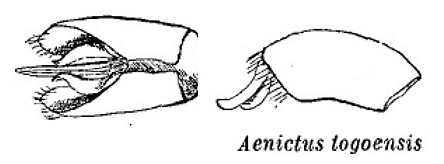 TL 4.5 mm; fawn rust;
appendages and apex of gaster yellow rust; decumbent pilosity fine,
long and white; resembling that of fuscovarius but more raised
and irregular on the head and members TL 4.5 mm; fawn rust;
appendages and apex of gaster yellow rust; decumbent pilosity fine,
long and white; resembling that of fuscovarius but more raised
and irregular on the head and members |
. |
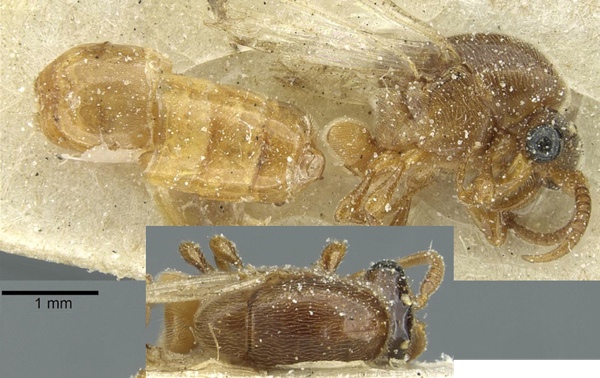 |
Togo - togoensis |
 TL 6.5 mm; head black and
alitrunk brownish, antennae, pedicel and gaster piceous; mandible and
legs ferruginous TL 6.5 mm; head black and
alitrunk brownish, antennae, pedicel and gaster piceous; mandible and
legs ferruginous |
. |
 |
Uganda - bayoni |
 TL
ca 5.5 mm; head blackish, alitrunk yellowish-brown, rest more
brownish-yellow; mandibles, scapes and legs with erect hairs; variety brunnea dark brown TL
ca 5.5 mm; head blackish, alitrunk yellowish-brown, rest more
brownish-yellow; mandibles, scapes and legs with erect hairs; variety brunnea dark brown |
. |
 |
Sahel - Senegal to Sudan
- soudanicus |
 TL 6.2-7 mm; tawny-yellow,
centre of dorsum of gaster segments darker; pubescence short and scanty TL 6.2-7 mm; tawny-yellow,
centre of dorsum of gaster segments darker; pubescence short and scanty
|
. |
 |
eastern Congo Basin and
East Africa - alluaudi |
 TL 6.5-7 mm; colour pale
testaceous, head brown, wings with pale nerves (as magrettii);
colour and pubescence as fuscovarius; petiole with copious
short hairs, from above wider than long, with rounded sides, the dorsum
lightly impressed TL 6.5-7 mm; colour pale
testaceous, head brown, wings with pale nerves (as magrettii);
colour and pubescence as fuscovarius; petiole with copious
short hairs, from above wider than long, with rounded sides, the dorsum
lightly impressed |
. |
 |
Kenya & Somalia - hamifer |
 TL 8-8.5 mm; yellow brown with
an olive tone; thoracic dorsum darker; head black; mandibles and legs
red-brown; veins of wings greenish brown TL 8-8.5 mm; yellow brown with
an olive tone; thoracic dorsum darker; head black; mandibles and legs
red-brown; veins of wings greenish brown |
. |
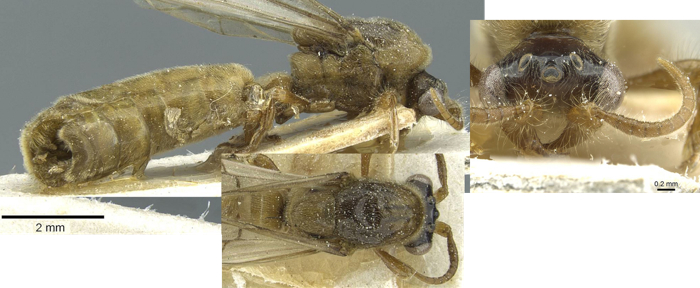 |
Sahel - Senegal to Sudan
- humeralis |
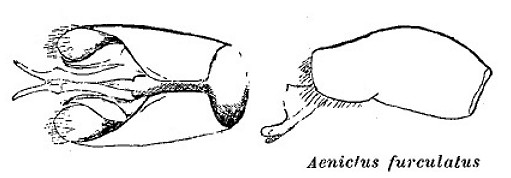 TL
6.5 mm; scape narrow, no wider than the widest funiculus segment;
mandibles 3.5 X longer than wide; ocelli quite large, lateral pair set
equidistant from median ocellus and the eyes; reddish-yellow; head with
vertex black, front brown; yellow erect pubescence on mandibles, scapes
and legs; pilosity fairly dense on the sides of the alitrunk and on the
dorsum of the gaster TL
6.5 mm; scape narrow, no wider than the widest funiculus segment;
mandibles 3.5 X longer than wide; ocelli quite large, lateral pair set
equidistant from median ocellus and the eyes; reddish-yellow; head with
vertex black, front brown; yellow erect pubescence on mandibles, scapes
and legs; pilosity fairly dense on the sides of the alitrunk and on the
dorsum of the gaster |
. |
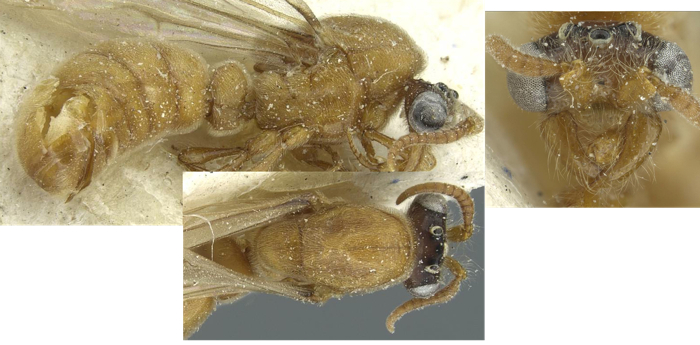 |
Sahel - Senegal &
Mali - furculatus
|
Group A2 - with
elongated narrow mandibles
|
|
 TL 6-6.5 mm: mandibles
elongated and slender; funiculus elongated; pale brown, head
darker; quite long erect hairs on head, scape, mandibles and apex of
gaster; alitrunk and gaster covered with long pubescence; ocelli
smaller than moebii and much bigger than on foreli TL 6-6.5 mm: mandibles
elongated and slender; funiculus elongated; pale brown, head
darker; quite long erect hairs on head, scape, mandibles and apex of
gaster; alitrunk and gaster covered with long pubescence; ocelli
smaller than moebii and much bigger than on foreli |
Ivory Coast & Benin -
mutatus
|
 TL 8.5 mm; dark brown, head
pitch brown; mandibles, antennae and legs reddish-yellow; ocelli
large TL 8.5 mm; dark brown, head
pitch brown; mandibles, antennae and legs reddish-yellow; ocelli
large |
. |
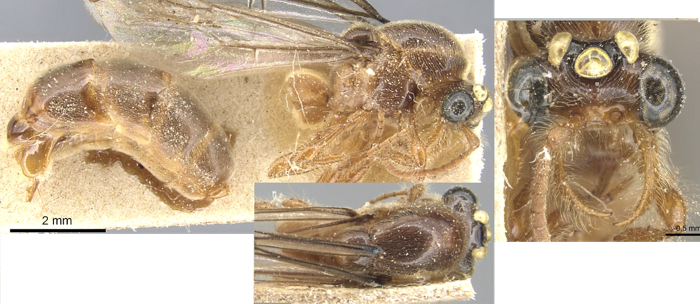 |
West Africa & Congo
basin - moebii |
 TL
5-5.5 mm; head and alitrunk
black, centre of gaster segments dark brown, remainder
reddish-brown, no original picture available but described as close to mutatus
but with smaller ocelli; mandibles long and sub-cylindrical TL
5-5.5 mm; head and alitrunk
black, centre of gaster segments dark brown, remainder
reddish-brown, no original picture available but described as close to mutatus
but with smaller ocelli; mandibles long and sub-cylindrical |
Ivory Coast & Central
African Republic - foreli
|
| Group B |
. |
 TL
6.5 mm; testaceous yellow, gaster paler; dorsum of head black behind
the ocelli, red-brown in front; mesonotum with distinct longitudinal
dark bands; sparse pubescence overall TL
6.5 mm; testaceous yellow, gaster paler; dorsum of head black behind
the ocelli, red-brown in front; mesonotum with distinct longitudinal
dark bands; sparse pubescence overall |
. |
 |
Mauritania
- mauritanicus |
 TL
7.5-8.0 mm; overall reddish; dorsum of head black; wings yellow with
the stigma a reddish brown; with quite dense pubescence overall;
mandibles about three times as wide as long TL
7.5-8.0 mm; overall reddish; dorsum of head black; wings yellow with
the stigma a reddish brown; with quite dense pubescence overall;
mandibles about three times as wide as long |
. |
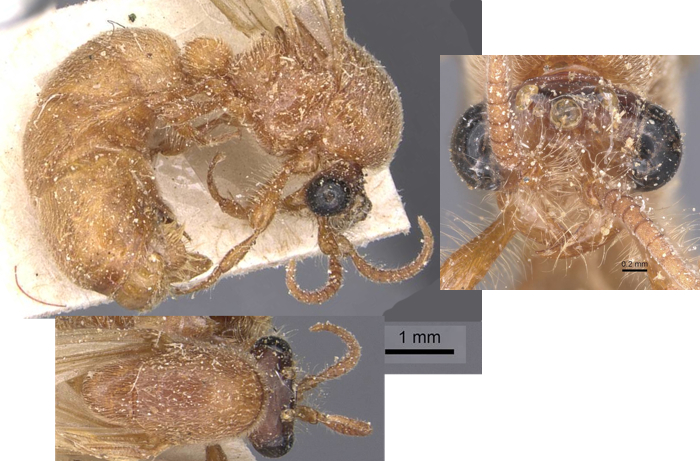 |
Ivory Coast & ? Ghana
- asperivalvus |
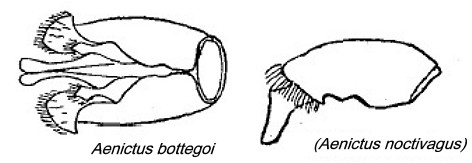 TL 6 mm; close to fuscovarius in form and colour TL 6 mm; close to fuscovarius in form and colour |
. |
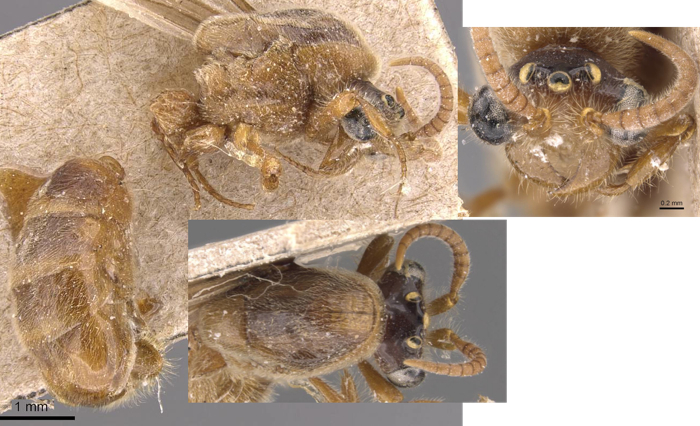 |
Ethiopia - bottegoi |
 TL
(sagittarius) 6-6.5 mm; overall colour honey-yellow, including
stigma and nerves; dense pubescence on the body and especially the
gaster; mandibles apparently short and arcuate, length about the same
as the clypeus is wide; petiole with a flat dorsum and sharp lateral
margins TL
(sagittarius) 6-6.5 mm; overall colour honey-yellow, including
stigma and nerves; dense pubescence on the body and especially the
gaster; mandibles apparently short and arcuate, length about the same
as the clypeus is wide; petiole with a flat dorsum and sharp lateral
margins |
. |
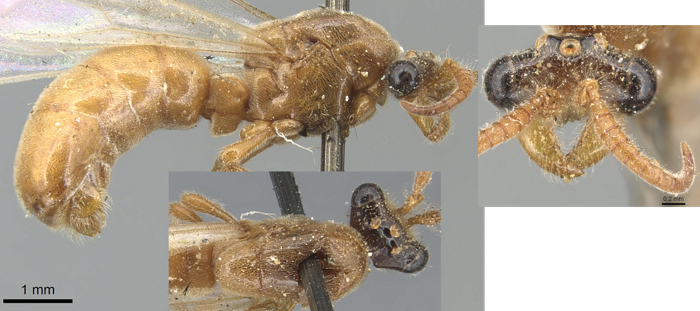 Image is of magrettii which may be a
separate species , TL from profile photo > 7.0 mm Image is of magrettii which may be a
separate species , TL from profile photo > 7.0 mm |
(note magrettii
seems wrongly synonymized) eastern Congo Basin and East Africa - fuscovarius
|
 General form and size [TL from
profile photo ca 9 mm] as fuscovarius
but head from above narrower, the postero-lateral borders more
rectilinear General form and size [TL from
profile photo ca 9 mm] as fuscovarius
but head from above narrower, the postero-lateral borders more
rectilinear |
. |
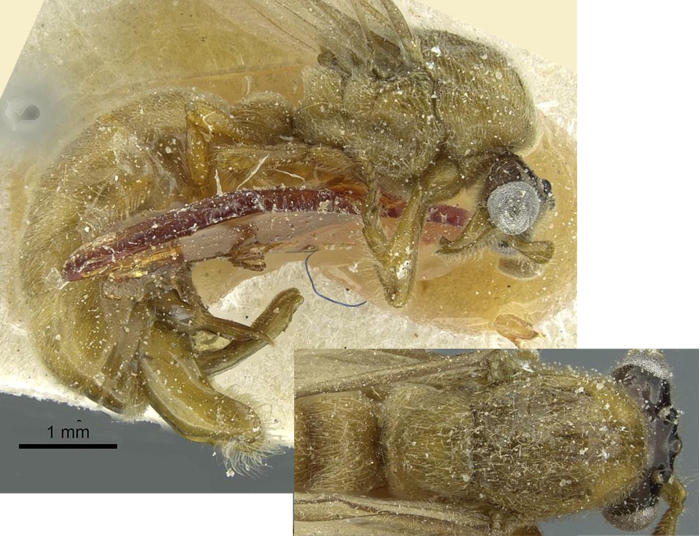 |
Sudan - pharao |
 TL 6 mm; flavo-testaceous;
antennae with short curved erect hairs TL 6 mm; flavo-testaceous;
antennae with short curved erect hairs |
. |
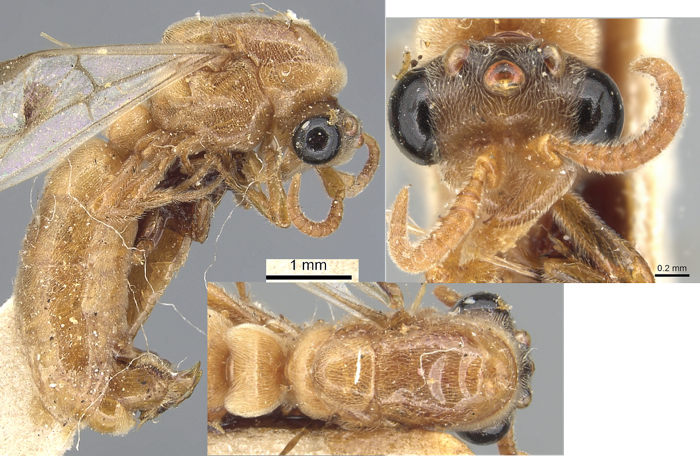 |
West African Sahel - luteus |
 TL 6.5 mm; a reddish-grey
colour; occiput, metanotum and apex of gaster very smooth and shiny TL 6.5 mm; a reddish-grey
colour; occiput, metanotum and apex of gaster very smooth and shiny |
. |
| |
Niger - vagans |
 TL 7.5-8 mm; wings less yellow
than asperivalvus; generally yellow brown TL 7.5-8 mm; wings less yellow
than asperivalvus; generally yellow brown |
. |
.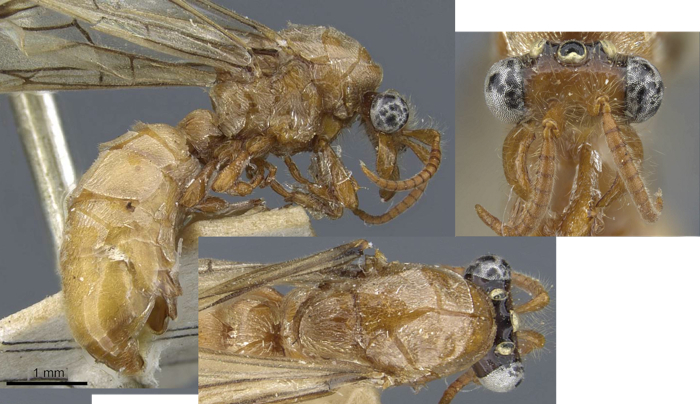 . . |
Eritrea - anceps |
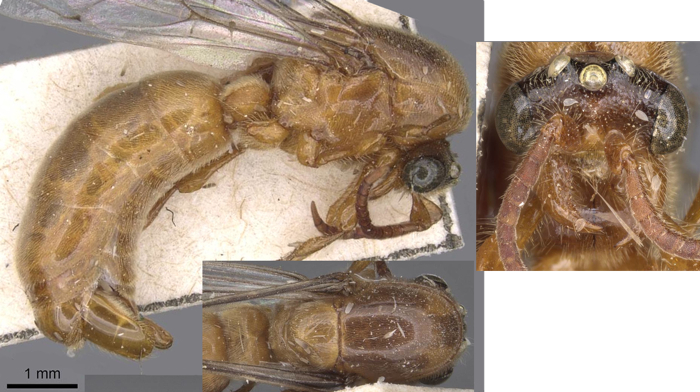 TL 9 mm; mandibles as buttgenbachi
but without a basal tooth; regularly attenuated from base to apex;
scape triangular, only 1.5 X longer than apical segment of funiculus;
yellow rust, with several areas of yellow brown on the alitrunk and
gaster; wings subhyaline, nerves and patch dark brown; no picture
available TL 9 mm; mandibles as buttgenbachi
but without a basal tooth; regularly attenuated from base to apex;
scape triangular, only 1.5 X longer than apical segment of funiculus;
yellow rust, with several areas of yellow brown on the alitrunk and
gaster; wings subhyaline, nerves and patch dark brown; no picture
available |
Zaïre - raptor |
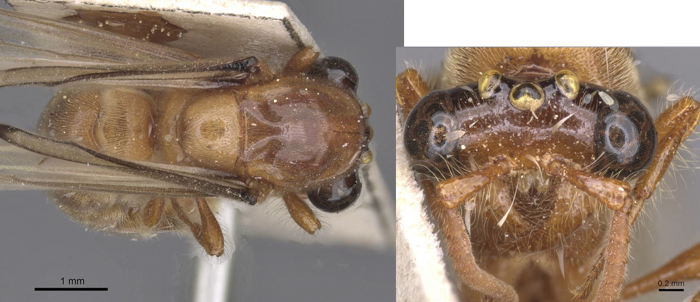 TL 9 mm; forewing 9 mm long;
no original drawing
available. Described as close to bottegoi
but clearly much
bigger; from photos clearly similar to raptor but HW 1.2X bigger;
mandible with a basal tooth; yellow rust; shiny but strongly
puncturate; legs, mandibles, scapes and underside of body with yellow
erect pilosity; otherwise only quite abundant yellow pubescence TL 9 mm; forewing 9 mm long;
no original drawing
available. Described as close to bottegoi
but clearly much
bigger; from photos clearly similar to raptor but HW 1.2X bigger;
mandible with a basal tooth; yellow rust; shiny but strongly
puncturate; legs, mandibles, scapes and underside of body with yellow
erect pilosity; otherwise only quite abundant yellow pubescence
|
eastern Congo Basin and
East Africa - buttgenbachi
|
| Group C - quite large primarily black
species |
. |
 TL 8 mm; head and alitrunk
black; mandibles, antennae, legs and gaster brownish-yellow with
the apex of the gaster olive tinted; overall with dense pubescence,
concealing the sculpturation; mandibles elongated, 4 X the basal width;
wings hyaline with the nerves brown and the patch brownish-black TL 8 mm; head and alitrunk
black; mandibles, antennae, legs and gaster brownish-yellow with
the apex of the gaster olive tinted; overall with dense pubescence,
concealing the sculpturation; mandibles elongated, 4 X the basal width;
wings hyaline with the nerves brown and the patch brownish-black |
. |
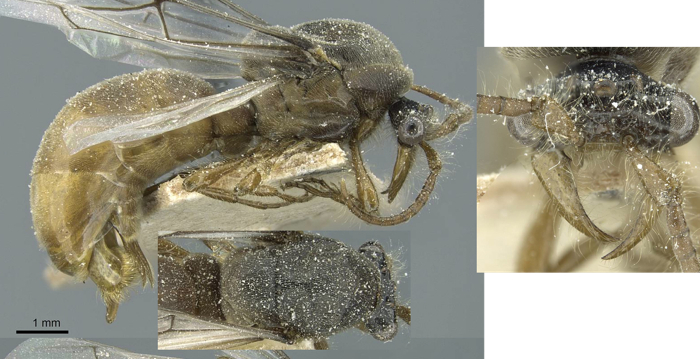 |
East Africa - crucifer |
 TL
ca 7 mm; overall cinereus-black; Arnold thought this might be the same
as A. crucifer (astuberculatus) TL
ca 7 mm; overall cinereus-black; Arnold thought this might be the same
as A. crucifer (astuberculatus) |
South Africa - inconspicuus |